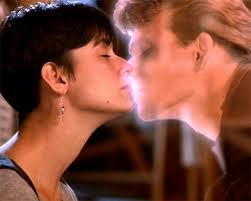Today’s post is by guest blogger Tim Conder. Tim is the founding pastor of Emmaus Way in Durham, NC and a PhD candidate in “Culture, Curriculum, and Change” at the University of North Carolina. He serves as a board member at The Seattle School of Theology and Psychology. He is also the author of two books, Free for All: Rediscovering the Bible in Community and The Church in Transition: The Journey of Existing Churches into the Emerging Culture and has contributed to many other publications.
It may just be me. These observations are not based on randomly assigned sample sets and pristine quantitative emp

irical methods.
But, thanks to the popular media, it feels like ghosts have gotten needier, more informative, and far less likely to be overwhelmingly frightening in the last couples decades. I’m not saying horrifying spirits are extinct. I still don’t walk in the woods at night all these years after The Blair Witch Project. There will be no standing face against the wall in the corner of a creepy forest hut for me if I can do anything to avoid it. But it does seem like more ghosts and spirits, if they haven’t gotten downright Casper-like friendly, are needier (The Sixth Sense), more whisper-able, more pathetic (Beetlejuice) or more altruistically motivated. Who can forget that final kiss between the ephemeral Patrick Swayze and his grieved wife (Demi Moore) in Ghost?
While some ghosts are helping us have the time of our lives, spiritless bodies have gotten infinitely more dreadful. Voldemort magically transformed dead bodies into an army of ghoulish inferi in the final volumes of the Harry Potter series. Flip the channel right now to HBO and you’ll gasp to see the icy white walkers in Game of Thrones turning dead bodies into soldiers that persist in assault even when dismembered. The Walking Dead…well, that is self-explanatory.
Bodiless spirits have gotten far more palatable and spiritless bodies are raising the stock value of night lights everywhere there is a cable jack, dish, or wireless router.
Of course, many theologians and philosophers might acknowledge the heightened quality of these popular culture images while explaining that our frightened fixation with bodies is anything but new. David Taylor pointed out in Sources of the Self, his long ideological history on the development of the notion of the modern individual, that a separation of bodies from souls has been a persistent and often prominent companion in the evolution of our anthropology. Paul Fletcher in an article entitled “Prolegomena to a Theology of Death” highlighted a nuanced but highly significant liturgical shift in the 16th century. In the burial service contained in the 1549 version of the so called “First Prayer-Book of Edward VI,” the priest throws dirt in the open grave and speaks to the corpse directly. In the revised Prayer Book of 1552, the corpse is now truly ‘the departed.’ Fletcher explained, “The switch from the second person to the third person is decisive. The body is now spoken of, rather than addressed directly, and is already and hereafter consigned to something or some place beyond the human community…The revised version constitutes the corpse as an object that is all but abandoned.” One might say that we have been historically prepared for both a zombie obsessed entertainment culture and, tragically, a ‘zombie theology.’
I just spent some time in a hospice suite of a dying family member with a portion of my extended family that I rarely see. This reunion of sorts was punctuated with lots of laughs, old stories, embellished lies, and many tears. Not surprisingly, there were also many quiet confessions and regrets expressed in and around the suite. At the end of any life, one seems compelled to take a look at one’s failures. As these wounds were exposed, I listened intently for sources of hope. My family comes from Christian tradition where the hope of faith is to be removed from a world of pain, to live abundantly in the presence of God without tears or even memory of the regrets and wounds that mark any human life.
In this hope, I certainly see the legacy of Edward VI’s second prayer book, an escape from the pains of our bodies and the wounds of our embodied lives but not the kind of restoration that also includes the full redemption of the whole of our lives and the whole of God’s creation. In the funeral that followed, I found great hope in reading and preaching on the familiar text of Ezekiel 37, the vision of dry bones being resurrected to life. The resurrection images of this text seem to so closely parallel the creative work of God described at Eden in Genesis 1-2, first a creation of forms and order (“I will attach tendons to you and make flesh come upon you and cover you with skin”) and then the intimate gift of God’s breath (“I will put breath in you, and you will come to life. Then you will know that I am the Lord.”).
The promise of Ezekiel 37 is remarkable: “I am going to open your graves and bring you up from them; I will bring you back to the land of Israel.” The open graves of resurrection are inextricably linked to the materiality of the promise of land. These are words are that we especially need to read today when I fear that an implicit gnosticism in our common philosophy yields a Zombie theology that diminishes our hope by robbing us of the breadth of the promises of God.
Don’t get me wrong, I’ll still keep a wary eye out for Voldemort’s inferi, George Martin’s white walkers, and all forms of the ‘walking dead.’ I just won’t fashion my hope around the implications of these images.












